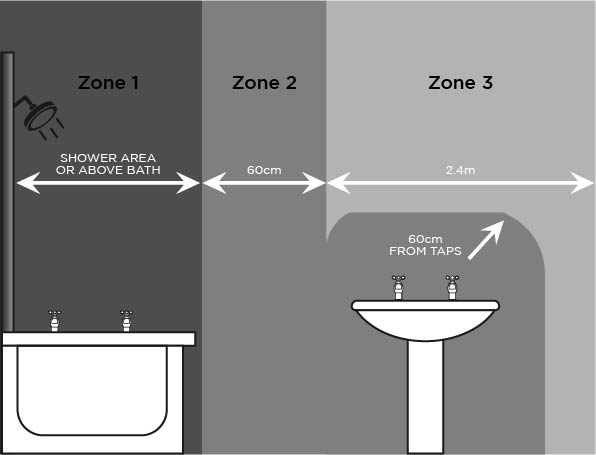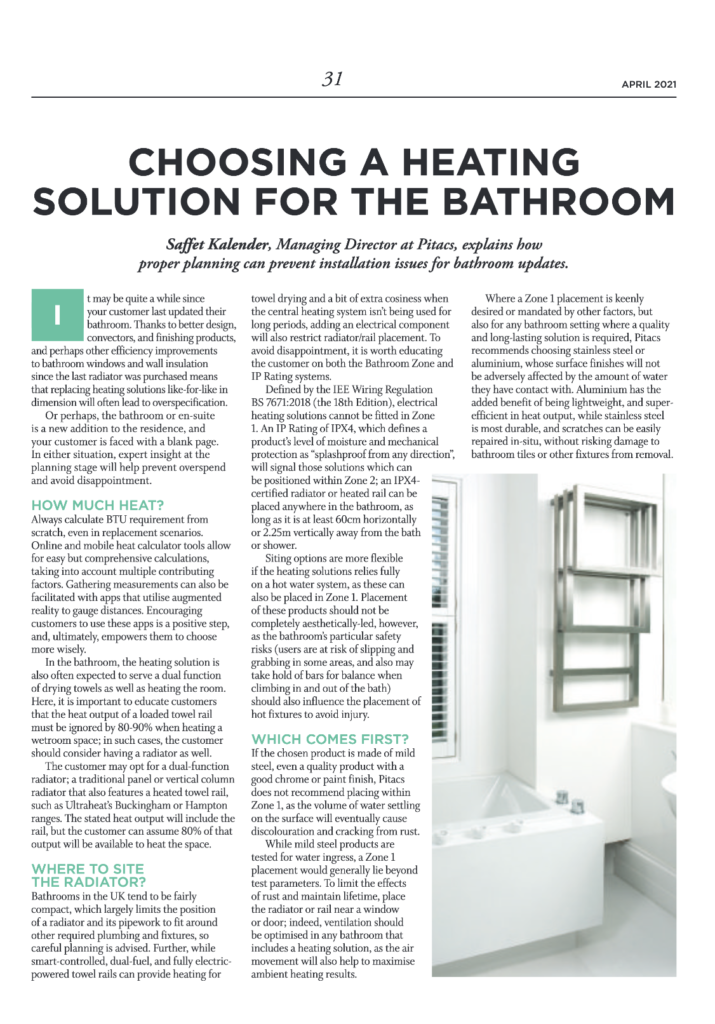| Featured in HVP Magazine April 2021 |
Saffet Kalender, Managing Director at Pitacs, explains how proper planning can prevent installation issues for bathroom updates.
It may be quite a while since your customer last updated their bathroom. Thanks to better design, convectors, and finishing products, and perhaps other efficiency improvements to bathroom windows and wall insulation since the last radiator was purchased means that replacing heating solutions like-for-like in dimension will often lead to over-specification.
Or perhaps, the bathroom or en-suite is a new addition to the residence, and your customer is faced with a blank page. In either situation, expert insight at the planning stage will help prevent overspend and avoid disappointment.

HOW MUCH HEAT?
Always calculate BTU requirement from scratch, even in replacement scenarios. Online and mobile heat calculator tools allow for easy but comprehensive calculations, taking into account multiple contributing factors. Gathering measurements can also be facilitated with apps that utilise augmented reality to gauge distances. Encouraging customers to use these apps is a positive step, and, ultimately, empowers them to choose more wisely.
In the bathroom, the heating solution is also often expected to serve a dual function of drying towels as well as heating the room. Here, it is important to educate customers that the heat output of a loaded towel rail must be ignored by 80-90% when heating a wetroom space; in such cases, the customer should consider having a radiator as well.
The customer may opt for a dual-function radiator; a traditional panel or vertical column radiator that also features a heated towel rail, such as Ultraheat’s Buckingham or Hampton ranges. The stated heat output will include the rail, but the customer can assume 80% of that output will be available to heat the space.
WHERE TO SITE THE RADIATOR?
Bathrooms in the UK tend to be fairly compact, which largely limits the position of a radiator and its pipework to fit around other required plumbing and fixtures, so careful planning is advised. Further, while smart-controlled, dual-fuel, and fully electric powered towel rails can provide heating for towel drying and a bit of extra cosiness when the central heating system isn’t being used for long periods, adding an electrical component will also restrict radiator/rail placement. To avoid disappointment, it is worth educating the customer on both the Bathroom Zone and IP Rating systems.
Defined by the IEE Wiring Regulation BS 7671:2018 (the 18th Edition), electrical heating solutions cannot be fitted in Zone 1. An IP Rating of IPX4, which defines a product’s level of moisture and mechanical protection as “splashproof from any direction”, will signal those solutions which can be positioned within Zone 2; an IPX4- certified radiator or heated rail can be placed anywhere in the bathroom, as long as it is at least 60cm horizontally or 2.25m vertically away from the bath or shower.

Siting options are more flexible if the heating solutions relies fully on a hot water system, as these can also be placed in Zone 1. Placement of these products should not be completely aesthetically-led, however, as the bathroom’s particular safety risks (users are at risk of slipping and grabbing in some areas, and also may take hold of bars for balance when climbing in and out of the bath) should also influence the placement of hot fixtures to avoid injury.
WHICH COMES FIRST?
If the chosen product is made of mild steel, even a quality product with a good chrome or paint finish, Pitacs does not recommend placing within Zone 1, as the volume of water settling on the surface will eventually cause discolouration and cracking from rust.
While mild steel products are tested for water ingress, a Zone 1 placement would generally lie beyond test parameters. To limit the effects of rust and maintain lifetime, place the radiator or rail near a window or door; indeed, ventilation should be optimised in any bathroom that includes a heating solution, as the air movement will also help to maximise ambient heating results.
Where a Zone 1 placement is keenly desired or mandated by other factors, but also for any bathroom setting where a quality and long-lasting solution is required, Pitacs recommends choosing stainless steel or aluminium, whose surface finishes will not be adversely affected by the amount of water they have contact with. Aluminium has the added benefit of being lightweight, and superefficient in heat output, while stainless steel is most durable, and scratches can be easily repaired in-situ, without risking damage to bathroom tiles or other fixtures from removal.


